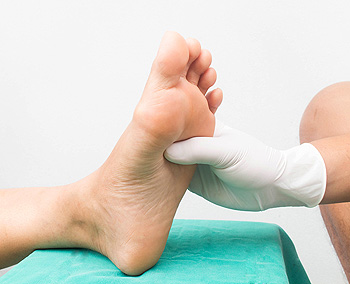The plantar fascia is the band of tissue on the soles of the feet that connect the front of the foot with the arch and the heel. When that tissue becomes inflamed due to stress or excessive stretching, plantar fasciitis can occur. Factors that can contribute to plantar fasciitis may include prolonged standing without proper footwear support, being overweight, having flat feet, high arches, or tight calf muscles. Pain from plantar fasciitis is often worse after sitting for a long period of time or in the morning, because the plantar fascia can contract while you are inactive or sleeping. If you have heel pain, it is suggested you make an appointment with a podiatrist who can examine you to make a proper diagnosis, and help treat whatever condition you may have using a variety of treatments and therapies.
Plantar fasciitis can be very painful and inconvenient. If you are experiencing heel pain or symptoms of plantar fasciitis, contact Mark Hupart, DPM from Southside Podiatry . Our doctor can provide the care you need to keep you pain-free and on your feet.
What Is Plantar Fasciitis?
Plantar fasciitis is the inflammation of the thick band of tissue that runs along the bottom of your foot, known as the plantar fascia, and causes mild to severe heel pain.
What Causes Plantar Fasciitis?
- Excessive running
- Non-supportive shoes
- Overpronation
- Repeated stretching and tearing of the plantar fascia
How Can It Be Treated?
- Conservative measures – anti-inflammatories, ice packs, stretching exercises, physical therapy, orthotic devices
- Shockwave therapy – sound waves are sent to the affected area to facilitate healing and are usually used for chronic cases of plantar fasciitis
- Surgery – usually only used as a last resort when all else fails. The plantar fascia can be surgically detached from the heel
While very treatable, plantar fasciitis is definitely not something that should be ignored. Especially in severe cases, speaking to your doctor right away is highly recommended to avoid complications and severe heel pain. Your podiatrist can work with you to provide the appropriate treatment options tailored to your condition.
If you have any questions please feel free to contact our office located in Brooklyn, NY . We offer the newest diagnostic and treatment technologies for all your foot and ankle needs.
Read more about Plantar Fasciitis Diabetic foot is a condition that can require a hospital stay for some diabetic patients. It is a condition that may cause the patient to lose feeling in their feet, which can make it difficult to feel a cut or a bruise. It occurs as a result of elevated blood sugar levels. It is beneficial to control the amount of sugar that is ingested, and this is often helpful in keeping glucose levels within a normal range. Additionally, many patients find their feet feel better when they are gently washed and dried, and trimming the toenails correctly may help to avoid cuts on the toes. It is important to incorporate gentle exercise into your daily routine, as this may help to improve circulation and overall health. If you have diabetes, it is strongly suggested that you are under the care of a podiatrist who can help you to properly manage any foot-related problems that may arise because of this condition.
Diabetic foot is a condition that can require a hospital stay for some diabetic patients. It is a condition that may cause the patient to lose feeling in their feet, which can make it difficult to feel a cut or a bruise. It occurs as a result of elevated blood sugar levels. It is beneficial to control the amount of sugar that is ingested, and this is often helpful in keeping glucose levels within a normal range. Additionally, many patients find their feet feel better when they are gently washed and dried, and trimming the toenails correctly may help to avoid cuts on the toes. It is important to incorporate gentle exercise into your daily routine, as this may help to improve circulation and overall health. If you have diabetes, it is strongly suggested that you are under the care of a podiatrist who can help you to properly manage any foot-related problems that may arise because of this condition.
Diabetic foot care is important in preventing foot ailments such as ulcers. If you are suffering from diabetes or have any other concerns about your feet, contact Mark Hupart, DPM from Southside Podiatry . Our doctor can provide the care you need to keep you pain-free and on your feet.
Diabetic Foot Care
Diabetes affects millions of people every year. The condition can damage blood vessels in many parts of the body, especially the feet. Because of this, taking care of your feet is essential if you have diabetes, and having a podiatrist help monitor your foot health is highly recommended.
The Importance of Caring for Your Feet
- Routinely inspect your feet for bruises or sores.
- Wear socks that fit your feet comfortably.
- Wear comfortable shoes that provide adequate support.
Patients with diabetes should have their doctor monitor their blood levels, as blood sugar levels play such a huge role in diabetic care. Monitoring these levels on a regular basis is highly advised.
It is always best to inform your healthcare professional of any concerns you may have regarding your feet, especially for diabetic patients. Early treatment and routine foot examinations are keys to maintaining proper health, especially because severe complications can arise if proper treatment is not applied.
If you have any questions please feel free to contact our office located in Brooklyn, NY . We offer the newest diagnostic and treatment technologies for all your foot and ankle needs.
Read more about Diabetic Foot CareThe Achilles tendon is located in the calf area and connects the calf muscles to the heel bone. When an injury occurs it can cause a rupture or tear of the tendon, and this can be quite painful. It can happen as a result of suddenly turning, and is common among people who occasionally participate in sporting activities. The Achilles tendon is the largest tendon in the body and plays an important role in walking, running, and pointing and flexing the foot. Many patients who have endured this type of injury can experience difficulty in pointing their toes downward, and the calf may become swollen and bruised as well. If you have pain in the heel or calf area it is suggested that you are under the care of a podiatrist who can properly treat an Achilles tendon injury.
Achilles tendon injuries need immediate attention to avoid future complications. If you have any concerns, contact Mark Hupart, DPM of Southside Podiatry . Our doctor can provide the care you need to keep you pain-free and on your feet.
What Is the Achilles Tendon?
The Achilles tendon is a tendon that connects the lower leg muscles and calf to the heel of the foot. It is the strongest tendon in the human body and is essential for making movement possible. Because this tendon is such an integral part of the body, any injuries to it can create immense difficulties and should immediately be presented to a doctor.
What Are the Symptoms of an Achilles Tendon Injury?
There are various types of injuries that can affect the Achilles tendon. The two most common injuries are Achilles tendinitis and ruptures of the tendon.
Achilles Tendinitis Symptoms
- Inflammation
- Dull to severe pain
- Increased blood flow to the tendon
- Thickening of the tendon
Rupture Symptoms
- Extreme pain and swelling in the foot
- Total immobility
Treatment and Prevention
Achilles tendon injuries are diagnosed by a thorough physical evaluation, which can include an MRI. Treatment involves rest, physical therapy, and in some cases, surgery. However, various preventative measures can be taken to avoid these injuries, such as:
- Thorough stretching of the tendon before and after exercise
- Strengthening exercises like calf raises, squats, leg curls, leg extensions, leg raises, lunges, and leg presses
If you have any questions please feel free to contact our office located in Brooklyn, NY . We offer the newest diagnostic tools and technology to treat your foot and ankle needs.
Read more about What are Achilles Tendon Injuries


